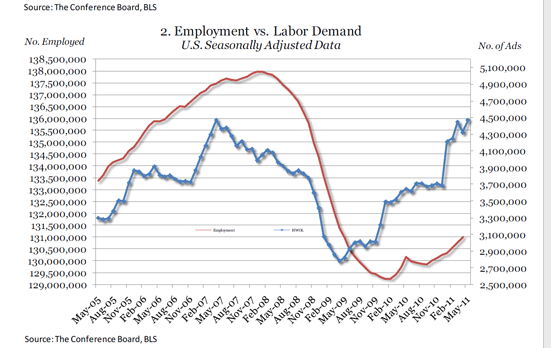This data backs what we have sen with temp. employment and we can see how the demand leads NFP’s. There is demand for workers out there, a lot of it. In fact it is the highest demand since before the recession. Why is unemployment so high? Why is the gap widening between the two series? It is the unintended consequences of government programs. When you pay people not to work for two years…….. surprise!!! They don’t work.
As all the unemployment extensions start to expire, we’ll see a surge of workers go back to work, because the job openings are there
Online Labor Demand Rises 148,800 in May, The Conference Board Reports
- Labor demand rises in May to pre-recession monthly high of 4.5 million advertised vacancies
- Labor demand up an average of 66,000/month over the last 4 months
- May marks an all-time high for 6 of 22 major occupation groups since the HWOL series began in May 2005
Supply/Demand for Selected Occupations
“In May, workers in 6 of 22 of the major occupations groups are finding the number of advertised vacancies is at the highest level since the HWOL series began in May 2005,” said Shelp. (HWOL does not include a separate category for the 23rd major occupation group, military occupations). The previous high for two of the six major occupational groups, Art, design, entertainment, sports and media, and Sales and related occupations were just prior to the official beginning of the recession in December 2007. For Building and grounds cleaning and maintenance and Transportation and material moving, previous highs were in December 2005. These occupational groups include a variety of occupations associated with both real estate and manufacturing (pest control, janitors and house cleaning in real estate and stock clerks, material handles and truck drivers associated with manufacturing output) which had already turned down before the official start of the recession. Computer and mathematical science and Personal care’s previous monthly highs were in early 2008.
